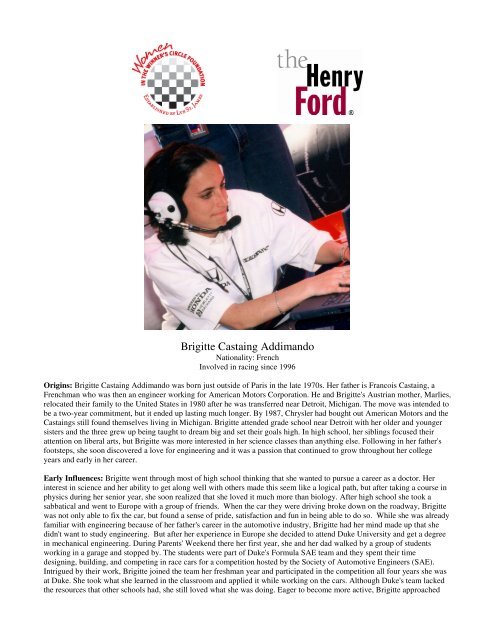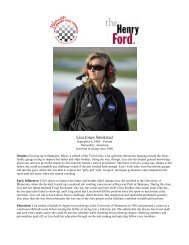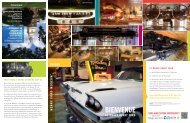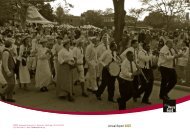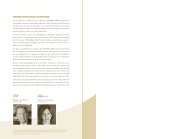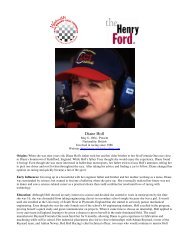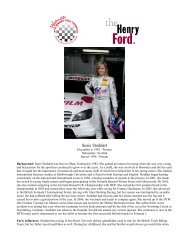Brigitte Castaing Addimando - The Henry Ford
Brigitte Castaing Addimando - The Henry Ford
Brigitte Castaing Addimando - The Henry Ford
You also want an ePaper? Increase the reach of your titles
YUMPU automatically turns print PDFs into web optimized ePapers that Google loves.
<strong>Brigitte</strong> <strong>Castaing</strong> <strong>Addimando</strong><br />
Nationality: French<br />
Involved in racing since 1996<br />
Origins: <strong>Brigitte</strong> <strong>Castaing</strong> <strong>Addimando</strong> was born just outside of Paris in the late 1970s. Her father is Francois <strong>Castaing</strong>, a<br />
Frenchman who was then an engineer working for American Motors Corporation. He and <strong>Brigitte</strong>'s Austrian mother, Marlies,<br />
relocated their family to the United States in 1980 after he was transferred near Detroit, Michigan. <strong>The</strong> move was intended to<br />
be a two-year commitment, but it ended up lasting much longer. By 1987, Chrysler had bought out American Motors and the<br />
<strong>Castaing</strong>s still found themselves living in Michigan. <strong>Brigitte</strong> attended grade school near Detroit with her older and younger<br />
sisters and the three grew up being taught to dream big and set their goals high. In high school, her siblings focused their<br />
attention on liberal arts, but <strong>Brigitte</strong> was more interested in her science classes than anything else. Following in her father's<br />
footsteps, she soon discovered a love for engineering and it was a passion that continued to grow throughout her college<br />
years and early in her career.<br />
Early Influences: <strong>Brigitte</strong> went through most of high school thinking that she wanted to pursue a career as a doctor. Her<br />
interest in science and her ability to get along well with others made this seem like a logical path, but after taking a course in<br />
physics during her senior year, she soon realized that she loved it much more than biology. After high school she took a<br />
sabbatical and went to Europe with a group of friends. When the car they were driving broke down on the roadway, <strong>Brigitte</strong><br />
was not only able to fix the car, but found a sense of pride, satisfaction and fun in being able to do so. While she was already<br />
familiar with engineering because of her father's career in the automotive industry, <strong>Brigitte</strong> had her mind made up that she<br />
didn't want to study engineering. But after her experience in Europe she decided to attend Duke University and get a degree<br />
in mechanical engineering. During Parents' Weekend there her first year, she and her dad walked by a group of students<br />
working in a garage and stopped by. <strong>The</strong> students were part of Duke's Formula SAE team and they spent their time<br />
designing, building, and competing in race cars for a competition hosted by the Society of Automotive Engineers (SAE).<br />
Intrigued by their work, <strong>Brigitte</strong> joined the team her freshman year and participated in the competition all four years she was<br />
at Duke. She took what she learned in the classroom and applied it while working on the cars. Although Duke's team lacked<br />
the resources that other schools had, she still loved what she was doing. Eager to become more active, <strong>Brigitte</strong> approached
one of her professors after her sophomore year about starting an intercollegiate association for engineering students interested<br />
in racing, where groups from various schools could buy stock cars, fine tune them, and practice racing them to get more<br />
hands-on experience. Students at other schools expressed similar interest in forming such a group. <strong>The</strong> association became<br />
known as ICAR (Intercollegiate Auto Racing Association) and <strong>Brigitte</strong> participated in it during both her junior and senior<br />
years. Like Formula SAE, it only helped to augment her love of engineering and urged her forward in her career goals.<br />
Education: <strong>Brigitte</strong> spent all four years of her undergraduate career studying mechanical engineering at Duke University.<br />
Although she was involved in a number of activities, it did not hurt her studies, as she repeatedly found herself on the honor<br />
roll. After graduating in 1999, she immediately enrolled in a graduate program at MIT and received her Master's degree in<br />
mechanical engineering just sixteen months later. She wrote her thesis about fuel efficiency with regard to engines and<br />
determined that for a minimal cost, a person could use a device to check what stroke of the engine a car was on when it was<br />
initially turned on. <strong>The</strong> device would reduce the need to immediately pour in large amounts of fuel to determine the stroke,<br />
thereby reducing the amount of exhaust. In addition to her undergraduate and graduate degrees, <strong>Brigitte</strong> also took two classes<br />
at MoTech, a mechanical trade school that allows students to become state certified mechanics. Of the students in attendance<br />
the year <strong>Brigitte</strong> enrolled, only two others were women, while the remaining fifty-eight were men. After working for a few<br />
years, <strong>Brigitte</strong> eventually returned to school and added to her already impressive resume by earning an M.B.A. degree from<br />
Harvard Business School in 2005.<br />
Career Path: <strong>Brigitte</strong>'s first real experiences applying her engineering skills came in 1996 when she began working on<br />
Duke's Formula SAE team. She continued to build on these skills two years later when she helped form and worked with<br />
ICAR. During the summer between her sophomore and junior years, she interned with Chrysler and worked on tuning and<br />
suspension jobs. She also spent time working with the design group there and increased her knowledge about the engine<br />
compartment. <strong>The</strong> following summer, between her junior and senior years, <strong>Brigitte</strong> interned with Penske's Racing team in<br />
Reading, Pennsylvania. She worked alongside the team engineer and chassis engineer and quickly became enamored with the<br />
idea of working out on the race track. <strong>Brigitte</strong> continued to improve her knowledge in engineering while at MIT and it only<br />
helped to enhance the hands-on work she had been doing in her internships and while at Duke. After applying for jobs in the<br />
latter part of 2000, she started working for Honda Performance on their race engine program. Based out of Santa Monica,<br />
California, she was assigned to Mo Nunn Racing for driver, Alex Zanardi, and she traveled with him wherever he went until<br />
his accident at EuroSpeedway Lausitz in September 2001. <strong>Brigitte</strong> was only twenty-three years old at the time. From 2001 to<br />
2003, she continued working for Honda for Indycar driver Tony Kanaan, who was also driving for Mo Nunn Racing. A year<br />
after Honda partnered with Ilmor, a British based motorsport engineering company, and the two groups began working<br />
together to develop Honda's Indy engines for the Indy Racing League. Although <strong>Brigitte</strong> was offered an opportunity to<br />
continue to work for Honda and move into Formula One, she decided it was time to pursue other goals and she left Honda in<br />
2003.<br />
Major Responsibilities: During her career in motorsports, <strong>Brigitte</strong> spent most of her time working on engines - building,<br />
improving, and testing them. Whether it was with Formula SAE or while working on her thesis, she was always determined<br />
to find a way to improve the engine and make it run as smoothly and efficiently as possible. At Honda Performance, her<br />
responsibilities included overseeing the changing of her team's engine, doing maintenance work, and trying to optimize how<br />
the engine ran. She was always busy, frequently working on the road with the team Wednesdays through Mondays before<br />
returning to California and doing it all over again a few days later.<br />
Becoming Established in the Field: Like other women who have come before and after her, <strong>Brigitte</strong> experienced multiple<br />
levels of adversity as she tried to earn respect in the motorsports world. She was the only female engineer at Honda in the<br />
early 2000s and many drivers were hesitant to accept her, assuming that she did not have the skill to successfully do the job.<br />
On her first day at Honda, the team owner went so far as to tell her that he would not work with girls and walked out. In<br />
addition to the criticism she faced because she was a young female, <strong>Brigitte</strong> also incurred judgment because she came only<br />
from an academic background. Some argued that there was a big difference between learning in school and learning on the<br />
job. However, <strong>Brigitte</strong> had been well-educated in engineering both inside and outside of the classroom and with her parents'<br />
support, she ignored her critics and pushed forward, determined to succeed.<br />
Advice to Others: Fully aware of the time commitment and dedication necessary for a career in engineering and<br />
motorsports, <strong>Brigitte</strong> believes that a person really has to love it to be able to do it. Oftentimes exhausting and grueling, the<br />
field can be very trying on one's lifestyle. Nevertheless, <strong>Brigitte</strong> claims there is also something romantic about engineering<br />
and that it can be an extremely rewarding job for those who are willing to devote their time and energy to it.<br />
Life off the Track: <strong>Brigitte</strong> spent the greater part of her college years and mid-twenties working in engineering and<br />
dedicating her time to learning all she could about the field. In 2003, she decided it was time to take a break from that world<br />
and left Honda to explore her other interests. In the last few years, she has worked as a Senior Director for Energy Plus and
just recently left this position. She enjoys photography, traveling, and running, and has participated in three half marathons.<br />
In 2007 <strong>Brigitte</strong> married and she and her husband have one child and they are expecting another. <strong>The</strong>y currently live in<br />
Philadelphia, Pennsylvania.<br />
Interesting Fact: Although she is no longer working in engineering or motorsports, <strong>Brigitte</strong>'s love for science and<br />
engineering still persists today. <strong>The</strong>re currently is a program in Boston where individuals help teach engineering in<br />
elementary schools through the use of nursery rhymes and short stories in an attempt to spark interest in the fields. <strong>Brigitte</strong>,<br />
who has spent her entire life helping mentor and tutor kids, hopes to be able to set up a similar type of program in the<br />
Philadelphia area.<br />
Awards and Achievements:<br />
• <strong>Brigitte</strong>'s Master's thesis was well-received and was eventually included in a book.<br />
• She was a lead engineer at Honda Performance and was the company's only female working on engines at the track<br />
in the early 2000s.<br />
• She received the Dean's Award from Harvard University in 2005 thanking her for her efforts in mentoring, tutoring,<br />
and counseling younger students. <strong>The</strong> award is given out to those who show strong leadership during their time at<br />
Harvard Business School and is considered one of the School's highest honors.


